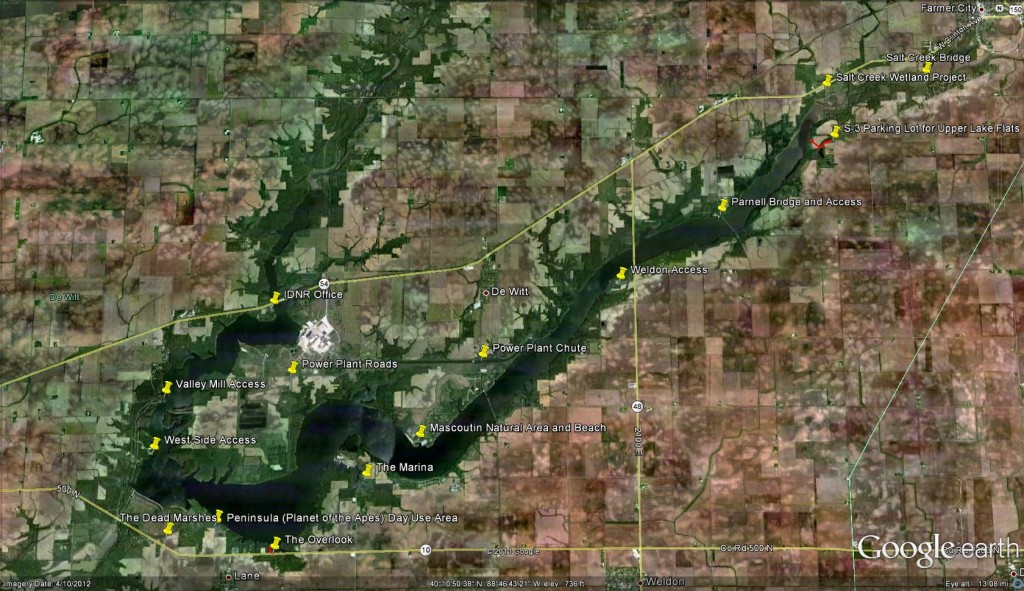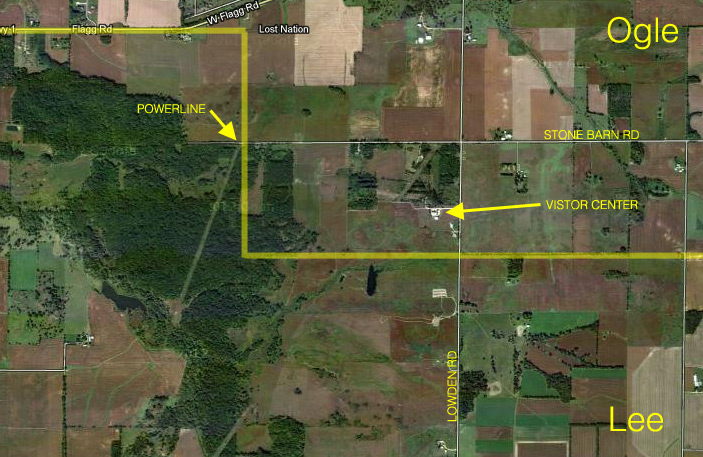CLINTON LAKE BIRDING AREAS:
Salt Creek Bridge on 2545/2550E: Sedge Wren, waterfowl, shorebirds when water levels are lower, raptors, Song Sparrows.
S-3 Parking Lot and the Upper Lake Flats off of 2400E: Phenomenal spot for shorebirds (at least 23 species have been seen here) when levels are lower. Great spot for waterfowl, gulls (Little Gull was seen here), terns, Pelicans, The IDNR lake on the way out often has good waterfowl also. The pines and thickets on the way out can be good for migrants. Rusty Blackbirds can be found here in season.
Salt Creek Wetland Project off of Route 54: Great place for Bell’s Vireo, Alder Flycatcher, Cuckoos, Yellow-breasted Chat during Spring migration. The wetlands have rails, both Bitterns, good waterfowl. When lake levels are full, this is a better place for shorebirds than the Upper Lake Flats. Sparrows can be thick in the prairie plantings on the way down to the wetlands. Wood Duck and Hooded Mergansers like this spot, as do Rusty Blackbirds in season. Red-shouldered Hawk is regular here. This a very good spot for Spring migrants. The area is closed to hunters on Saturdays.
Parnell Bridge and Access off of 2225/2300E: This is the only bridge that is safe to stop on at Clinton. Large congregations of Goldeneye and Mergansers can be found here in migration. Gulls roost on the ice around this bridge in Winter. The Access itself is a very good Spring migrant spot, as well as the best spot on the lake for Purple and House Finch, and Pine Siskin and Redpoll in season. The horse trail that goes east from the road can be very good for frugivores and sparrows. Accipiters seem to frequent here also. The pines in the NW area sometimes harbor Barred Owls.
Weldon Access off of 2100E: This is another good Spring migrant location. The path through the pines has harbored year-round Barred Owls for a couple of years now. During migration, the far shore has thousands of dabbling ducks along with large groups of Mergansers but a scope is required. This is a good spot to watch Bonaparte’s Gulls. Pine Siskins are commonly here using the Black Alders. Belted Kingfisher and Bald Eagles are also often at this spot. Pileated Woodpeckers have been heard in the woods across the lake.
Mascoutin Rec Area and Beach: the drive in can be good for Meadowlarks, Raptors, and Sedge Wren in season. There is a nice nature trail going left at the T where the beach entrance is that is very good in Spring and Fall migration. The beach behind Boondock’s (excellent fish and good food here when it’s open) usually has Gulls and sometimes terns and shorebirds. There are lots of pines and cedars at Mascoutin worth checking for any of the owls (Great-horned, Barred, Long-eared and Saw-whet).
Power Plant Chute just north of Mascoutin: This spot has lots of diverse waterfowl during migration and in winter. Pull-off south of the bridge and scope from the area above the chute.
North of here in De Witt is the Dewitt General Store — one can get food and beverages here.
Power Plant Roads: Several roads behind the Power Plant offer good roadside birding. Everything here is private so stay on the roads. Bluebirds, Mockingbird, Shrikes (rare), Blue Grosbeak, Red-headed Woodpecker (rare), Rough-legged Hawk, raptors, and passerine migrants are all possible back here.
IDNR Office: This is a good spot for waterfowl and gulls. Scope from the lawn of the office, but have identification on you!! They will come out and run your license if they see people scoping the power plant. Goldeneyes like this spot.
Valley-Mill Access off of 1400E: Decent migrant spot for passerines. Good place to scope from the fishing deck to the north for loons, grebes, waterfowl, gulls, and eagles.
West Side Access: Good Spring/Fall migrant spot driving in and hiking a small loop that goes from the SE corner of the parking lot down to the actual boat access. The basin here often has loons, gulls (once a Black-legged Kittiwake), terns, and Coots. Horned Grebe concentrations can be large here in season. Pileated Woodpeckers have been seen and heard in the woods across the lake from here.
The Dead Marshes (Yellow Rail Wetland): This is a brutal place. Park and hike down the teasel infested slope into the marshes. If there is water in them, prepare for ankle deep dipping. Sora, Virginia Rail, Yellow Rail (in season and rare), Swamp, Nelson’s and Le Conte’s (very good spot) Sparrows, Northern Harriers, Short-eared Owl in Winter, and Wilson’s Snipe all can be found down here with effort.
Peninsula Day Use Area off of 1500E: Either road — the one that goes back to the old day use area, or the one that goes straight to the lake, are very good for birds year round. Purple finch and Black-billed Cuckoo like the road back to the day-use area. Going down the other old road gets one to a good scoping spot. Look for loons, grebes, waterfowl rafts (both Pacific Loon and Surf Scoter have been seen from this location). Get to the lake softly as here the birds are sometimes pretty close and in good south light.
The Overlook: I recently flagged the parking spot and the path back to the Overlook, yet it can still be hard to find. Park on the north greenway shoulder as FAR off the road as possible. Hike back looking for migrants in season. Scope the entire basin from the Overlook slowly and repeatedly. This is the best spot for Red-throated Loon. Scan for loons, grebes, waterfowl, gulls, and terns.
The Marina: The muddy flats just before the marina entrance can be good for waders and shorebirds. Redpolls have been sen around the marina in season, This is also a good Wild Turkey spot. Scope the docks off of the marina for gulls and terns. Also scope the water for loons, grebe, waterfowl, and gulls.
Below is an aerial with these spots pinpointed.

View Larger Map

